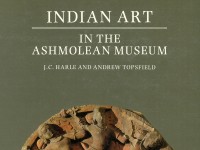Indian Art in the Ashmolean Museum
A catalogue of the Ashmolean’s collection of Indian art by J. C. Harle and Andrew Topsfield (published Oxford, 1987).

Publications online: 143 objects
- Reference URL
Actions
Stucco head of a man
-
Literature notes
In almost all cases such detached heads once belonged to a complete figure, sometimes in groups, more likely placed singly. This example, a “Socratic” type head of purely western classical inspiration, shows the ability of the sculptor in Gandhara to copy purely foreign types as a variant from the standardised heads of Buddhas and Bodhisattvas which were his stock in trade. To the contemporary Buddhist worshipper, versed to some extent in Brahmanical lore as he probably was, this personage was likely to represent a rsi or sage. The heads, sometimes secured to the bodies with a wooden peg, were easy prey to vandals and spoliators but there is evidence that at times they simply dropped off. It can rain abundantly in Gandhara, obliterating the carving in the easily soluble stucco. A head in the Museum’s collection shows where a fresh coating of stucco was applied, in which the features were modelled anew. -
Details
- Associated place
- Date
-
2nd half of the 3rd century - 4th century AD
Kushan Period (AD 50 - 600)
- Material and technique
- stucco
- Dimensions
-
with mount 21 x 9.5 x 9 cm max. (height x width x depth)
14 x 9.5 x 9 cm max. (height x width x depth)
- Material index
- Object type index
- No. of items
- 1
- Credit line
- Presented by E. M. Scratton, 1958.
- Accession no.
- EA1958.2
-
Further reading
Harle, J. C., and Andrew Topsfield, Indian Art in the Ashmolean Museum (Oxford: Ashmolean Museum, 1987), no. 22 on p. 17, p. 21, illus. p. 17
Penny, Nicholas, The Materials of Sculpture (New Haven: Yale University Press, 1993), illus. p. 195
Location
Objects are sometimes moved to a different location. Our object location data is usually updated on a monthly basis. Contact the Jameel Study Centre if you are planning to visit the museum to see a particular object on display, or would like to arrange an appointment to see an object in our reserve collections.
Galleries
Publications online
-

Indian Art in the Ashmolean Museum
In almost all cases such detached heads once belonged to a complete figure, sometimes in groups, more likely placed singly. This example, a “Socratic” type head of purely western classical inspiration, shows the ability of the sculptor in Gandhara to copy purely foreign types as a variant from the standardised heads of Buddhas and Bodhisattvas which were his stock in trade. To the contemporary Buddhist worshipper, versed to some extent in Brahmanical lore as he probably was, this personage was likely to represent a rsi or sage. The heads, sometimes secured to the bodies with a wooden peg, were easy prey to vandals and spoliators but there is evidence that at times they simply dropped off. It can rain abundantly in Gandhara, obliterating the carving in the easily soluble stucco. A head in the Museum’s collection shows where a fresh coating of stucco was applied, in which the features were modelled anew.
Notice
Object information may not accurately reflect the actual contents of the original publication, since our online objects contain current information held in our collections database. Click on 'buy this publication' to purchase printed versions of our online publications, where available, or contact the Jameel Study Centre to arrange access to books on our collections that are now out of print.
© 2013 University of Oxford - Ashmolean Museum











